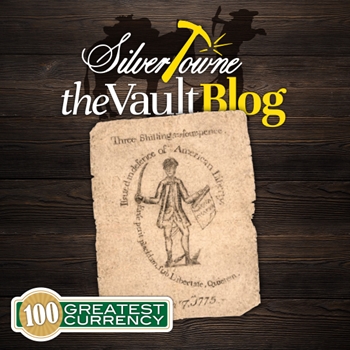
The city of Boston, Massachusetts, has a number of famous people attached to it. While you would be correct in rattling off certain actors and celebrities, we are thinking more historically. Benjamin Franklin, Sylvia Plath, Samuel Adams, Edgar Allan Poe, and more. However, one of the most famous to come from the birthplace of the American Revolution is Paul Revere. The midnight rider himself would bring value to anything, especially when it comes to numismatics. That is exactly the case in our next entry in the 100 Greatest American Currency Notes blog series. As authors Q. David Bowers and David M. Sundman help us navigate this Whitman Publishing publication, we take a closer look at a note from the same time period as Revere that has long since been a collector favorite regardless of its scarcity.
#94 - By Paul Revere Massachusetts “Sword In Hand Note”
These Massachusetts notes are from plates engraved by Paul Revere. Depicting a patriot with “sword in hand,” there were many denominations produced dated both 1775 and 1776. The first authorization of notes were dated August 23, 1775, and were featured with the £100,000 face value. Its equivalent was around $450,000 in Spanish milled dollars (a milled dollar is a silver coin worth eight Spanish reales). A number of notes had been printed during this time as it was also the period of time in which the first authorization of federal currency was given by the Continental Congress on May 10,1775 (this was also in Spanish milled dollars as U.S. dollars were not produced in coin form until 1794). At the time, it was procedural for colonies and others who issued paper money to use the English form of currency which resulted in pounds, shillings, and pence, or the Spanish milled dollars.
The first of the Sword in Hand notes from the issue date of August 18, 1775, were issued in a number of denominations. This includes 1s, 2s, 2s6d, 4s, 5s, 6s, 7s6d, 8s, 10s, 11s, 12s, 17s, 20s, 24s, 30s, and 40s. While there were a number of monetary denominations varying just slightly, the notes became a target for counterfeit currency. Each of the notes included information about the dates they were authorized and redeemed. The backs featured the denomination and the date along with the patriot figure standing wearing a coat with a sword in his right hand. MAGNA CHARTA is seen on the scroll the patriot is holding in his left hand while an inscription surrounding the man reads “Issued in defence of American Liberty,” and “Ense petit placidam, sub Libertate, Quietem,” which translates to “By arms he seeks peace with freedom.”
These notes not surprisingly had a short life span once they entered into circulation. They would quickly become replaced with other issues. In 1960, the historic market value for the 600-1,000 of these notes known in a Very Fine condition was $350. In 2006, it jumped to $11,000.







